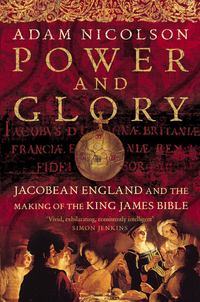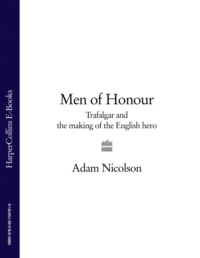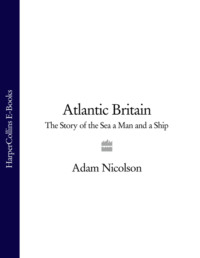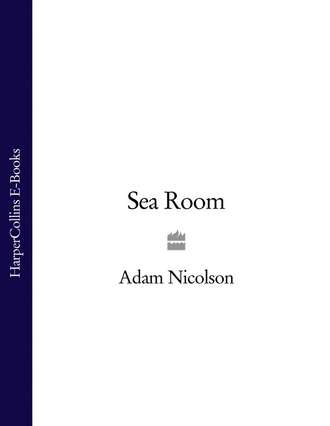
Полная версия
Sea Room
It would have been tricky work, getting the dinghy away from the beach, with the sea coming straight on to them, then sailing the boat away from the now aggressive and surf-lined shore. These long-keeled, broad-beamed boats do not point high into the wind. You are lucky if you can bring the boat to within sixty degrees. The wind that day had become a gale. The seas as they arrived at the Shiant shore were kicking up into long, whitened combers, driving into the notches and crannies of the coastline where they burst into plumes reaching fifty or sixty feet on to the grass. But the boys knew what they were doing. Keeping just out from the shore, with the boat on a broad reach, they could make their way to the far corner of Garbh Eilean. Donald Campbell told their fathers that he had watched them get away, pulling with the oars to begin with and then hoisting the sail, covering the mile or so westwards at a fair pace, reaching the far point of Garbh Eilean, the headland called Stocanish, before disappearing around the corner.
No one can know what happened next. Out there, beyond Stocanish, in a southwesterly gale, with the tide ebbing southwards, can be as good a version of hell as the Hebrides can offer. I have taken Freyja in there on a bad day; not a gale but blowing perhaps Force 5 or 6 with the ebb coming down from Cape Wrath. The sea picks up. When you are in among it, there seems to be no pattern. It stands in little peaks all around you, like the points into which the whipped whites of egg can be made to stand. Or more like that miniature thorny landscape which is left behind if you pick one recently glued plank away from another. As the two separate, the glue is pulled up into little pinnacles with sharp, cup-shaped valleys between them. There is no structure to this form, no readable order, just a little world of mobile chaos, a dancing three-dimensional spiky surface through which you can only hope to make your way. It is disconcerting even in a slight wind, the randomness of it, the unpredictability of those mobile pin-ranges, the lurching and jumping of the boat from one side to another, the steep little walls of sea that the wind makes against the tide, the picture of anarchy and its primordial threat. If you increase the energy in that system, if you turn a gale on to it, if you make these water pinnacles eight rather than four feet high, this stretch of sea would be unsailable.
After an hour or so the Campbells started to get worried. The Lemreway boys had not come back to the house. Donald sent his son John, a blond giant who was deaf and dumb, down to the beach connecting Garbh Eilean and Eilean an Tighe to see if he could make out what was happening in the bay. John returned, highly agitated, somehow communicating to his father the fact that the boat was not to be seen. It had vanished. The Lemreway boys had left their provisions in the Campbells’ house. Clearly they had been intending to stay. Where were they now? The Campbells guessed, or so they told the Lemreway men the next day, that once the boys had got round the corner at Stocanish, they had thought they had better run for home. As soon as the fathers heard this from Donald Campbell, they knew the boat was lost, and without pause set off for the Lewis shore. They searched loch after loch there, hoping to find the boys sheltering from the storm, or driven in there perhaps with their gear broken. They nosed into all the corners of Loch Claìdh, into Bagh Ciarach, Loch Valamus, Loch Bhrollúm, at Camas Thomascro, at Mol Truisg and in the further reaches of Loch Sealg. Their sons were in none of them.
It wasn’t a stupid exercise. The Lewis coast has always provided shelter from the Stream of the Blue Men but in 1881 the boys from Lemreway were never seen again. The rudder of the boat was found a little later washed up on the Mol Bhan, the blond beach, near Orinsay, a few miles west of Lemreway. Timber was scarce in the Hebrides and the rudder was used for more than forty years as a foot-bridge across the stream that runs down over its pale pebbles on to the beach there. It was the way people took back to the village from the peat-bank and nothing was more welcome, when loaded down with peats, than to find the stream properly bridged, an easy step or two across a difficult passage.
A few weeks later, a rudderless Orkney-built boat was found drifting around Cape Wrath, seventy-five miles away to the north. It was recognised by the Lewis fishermen who came across it as the boat that had been lost at the Shiants. There were sickles stowed away in the gunwale. Shortly before the boys had taken the boat to the islands, it had been used for gathering the seaweed that was to be spread on the fields just before the spring sowing of the oats and the barley. The sickles had been left aboard, jammed between the gunwale and the stringer. The sea had clearly turned the boat over twice: once to drown Murdo Macmillan, John Macinnes, Angus Ferguson and Donald Macdonald, and once to set it on its way again to Cape Wrath, with its cargo of sickles intact.
In 1910, another generation of boys, this time from the village of Gravir, just north of Lemreway, set off on the same summer expedition for the Shiants. The party included fourteen-year-old Donald MacPhail. It was the ‘last sad summer of my boyhood’, as he wrote as an old man, before he was sent away as a scholar to the Nicolson Institute, the secondary school in Stornoway, to fulfil his father’s ambitions for him to have ‘a gentleman’s job, chained to a desk, a school room, pulpit or doctor’s surgery.’ He was going to make the best of his last weeks of freedom.
One fine day, with three other boys, I decided to make a hail and farewell trip to the Shiant Islands. My father was away fishing, and my mother did not like the idea very much; however my heart was set on the trip and after getting up early and packing some food and drink in a small cask, we set sail, swathed in the calm early morning sunshine.
When they arrived, they ‘roamed all over the island, collected a lot of eggs and watched the thousands of birds that assembled on the cliffs. We had taken shotguns and ammunition and passed the time away shooting at the puffins.’
Only on the way home from their puffin-shooting trip did the schoolboy crew find themselves in trouble. As they left the Shiants, the wind that day seemed suddenly to get up from the north-west – almost precisely the direction they needed to go – and the boat had far too little weight in it to push itself into the wind.
The bright calmness of the morning gave way to a darkening moody sky and we began to have difficulty beating against the wind in our light, unballasted boat. As the sea got choppy we shortened the sail and had to take it in turns to bale out furiously as the spray washed over the boat making it harder for us to steer and retain control.
Eventually, after many hours, late in the evening, they managed to get into the shelter of Kebock Head, tucked in under its big brutish cliffs, which could protect them from the northwesterlies. A little pool of still water lay under the lee of the headland itself. There they had to wait on their oars, unable, with this wind, to sail up Loch Odhairn into Gravir. At midnight, the boys heard the thudding note of a propeller. They set light to a tarred rag and attracted the attention of a trawler which towed them home. Their parents were out searching on the headlands and nobody noticed the trawler coming into the loch bringing their sons in from the sea. The last hope, so they guessed, was that the boys might be sheltering under Kebock Head, and the Gravir families made their way there across the moor. ‘When they arrived at the Cabag [the Gaelic spelling of Kebock Head] and discovered that there was no sign of our whereabouts they feared the worst.’ Donald MacPhail put the experience behind him. ‘The menacing mass of the Shiant Islands,’ he wrote many years later, ‘never again held any mystery for me. Only a painful memory. My father saw to that.’
A famous and beautiful Gaelic song, still sung at ceilidhs and in the great annual competition, the Mod, can stand for all the laments over those who have drowned in the Shiant seas. In the spring of 1786, the young and handsome Allan Morrison, a shipmaster from Stornoway, who usually traded between Lewis and the Isle of Man, took his boat down the coast of Lewis to Scalpay, where he was to be engaged to Annie Campbell, Campbell of Scalpay’s daughter. In the Stream of the Blue Men, off the Shiants, the wind turned, as it does, his boat was swamped and he and all his crew drowned. Annie Campbell, broken with grief, wasted away and soon died herself. There is no burying ground on Scalpay. The soil is too thin and still today the Scalpay dead are carried over to the sandy soils on the Atlantic side at Luskentyre to be buried. Annie Campbell’s father took her body in a coffin by boat to the most distinguished of all the burying grounds in Harris, at Rodel, in the south-eastern corner of the island. On the way there, another storm came up at them and to lighten the boat, the coffin had to be thrown overboard.
Soon afterwards, the body of Allan Morrison was found washed up on the shore of the Shiants and a few days later Annie’s body was found at the same place.
The song – this is the Shiants’ only brush with Hollywood: it was sung in the film Rob Roy – is in the voice of Annie Campbell, grieving on Scalpay for her lost lover. It survives in many versions, some of them still sung in Cape Breton, in Canada, where the descendants of emigrating Hebrideans took it in the nineteenth century.
Brown-haired Allan, ó hì, I would go with thee; hó rì rì rì u ho, e o hùg hoireann ó, Brown-haired Allan, ó hì, I would go with thee.
I am tormented,
I have no thought for merriment tonight
but only for the sound of the elements
and the strength of the gales …
And brown-haired Allan, my darling sweetheart,
I heard you had gone across the sea
on the slender black boat of oak …
Brown-haired Allan, my heart’s darling,
I was young when I fell in love with you.
Tonight my tale is wretched.
It is not the tale of the death of cattle in the bog
but of the wetness of your shirt
and of how you are being torn by the whales.
I would drink a drink, in spite of everyone,
of your heart’s blood,
after you had been drowned.
4
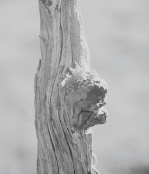
I TAKE THE BOAT SLOWLY in to the beach. Her iron-shod stem slides, grates and then halts on the stones. I jump ashore and push the small grapnel anchor between the shingle. It is a way of pinning the boat to the island. However seasick I feel, this of course is the moment. I am walking at last on the familiar shore, awash with the familiarities of the place: the slip of one stone against another, the smell of the seaweed rotting in the nostrils, knowing without even watching them the flickering presence of the birds as they take this route between the islands, the great inviting wings of land spreading out on all sides, the surge and draw of the sea on the shingle. And above all that, the core sensation of island life: knowing the world is held at arm’s length by that sea, afloat on the privacy, buoyed up by the knowledge that here I am alone. It can, oddly enough, be a shared feeling. I remember arriving here one morning with John Murdo Matheson, the young shepherd from Gravir, a man, if this is possible, more in love with the Shiants than I am. We were waving goodbye on the beach to the fishing boat that had brought us, watching its wake curve around the rocks of Garbh Eilean, and he said to me, not looking at me, but our shoulders rubbing, ‘It’s as if the world’s been cut off with a knife, isn’t it, Adam?’
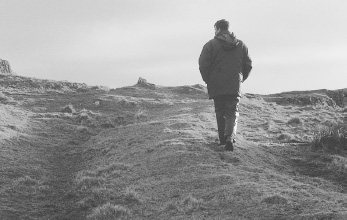
But now I am alone and I inspect the place, the first time I have been here since the previous autumn. It is like looking through old letters, a slowly growing recognition of a well-known thing, its atmosphere stealing up on you, enveloping you like the smell of bread from an oven. Your body remembers the movements of island life: the hauling of the boat up the beach, the tying it on to the mooring ring, the touch of sun for a moment, the endless wind, as if you were listening all day to the whispered roaring in a shell held up to your ear.
But the beach looks odd. In summer, it extends between Garbh Eilean and Eilean an Tighe in a smooth and well graded expanse of pebbles, cleanly sifted and sorted in a shallow grey arc between the rocks of the islands on either side. Now, in April, it looks as if a team of bulldozers have been at work over the winter. The enormous volume of stone which in summer makes up the centre of the beach, one hundred and fifty yards of it, thirty feet high and a hundred across, has been shouldered aside, roughly barged into mounds which are humped up against the rock buttresses of the islands. This is the work of the winter storms, an unthinkable battering. A third of the fence posts along the cliff edge are broken off at their base, pieces of perfectly good square-section timber, four inches by four, snapped and held now by the wire they were meant to support. Posts don’t last long. After they have been here a year or two, the winter wind has so picked away at the wood that they have returned to younger versions of themselves. The little side stems of slightly harder timber which had been buried by later growth as knots, have withstood the eroding wind and now stand out from the shrunken post as truncated branches. Each post looks like a fossil tree.
I unload Freyja, piling my belongings on the beach above the rising tide. It takes half an hour. Then I row Freyja out to a depth where she will not ground at low tide, anchor her there, inflate the dinghy, row ashore, pull the dinghy up the beach and tie it fast to the wrought iron rings which are hammered into cracks in the rocks.
The landing beach is two hundred yards or so from the house and everything must be carried up over a small rocky rise and then along a level grassy platform to the door of the house. It is, through sheer repetition, the most familiar two hundred yards of the islands, as known to me as the knots in the desk on which I write or the feeling of my teeth to my tongue: the slightly awkward shuffles across that rock step; the point where the path crosses a smooth piece of turf, next to the boulder on which a pincushion of thrift produces two or three blooms in the summer; the little spring, just beyond the small ridge that separates it from the beach, where the path curves round above the shore. The spring is stone-lined, with rushes fringing its edges and a flat stone placed at its lip, on which a bucket can stand while you fill it. Past two ruins of abandoned houses, through a patch of nettles and there, on its little coastal shelf, with the silverweed thick around it, and all the pens and fences in which the sheep are gathered for the marking of the lambs in May, the shearing in July and the autumn cull, you come to the house.
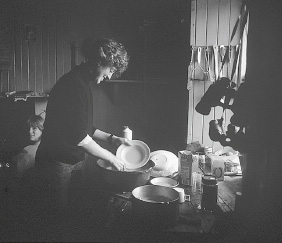
Although I love the building, it is in truth, little more than a shelter in a storm. This is, at heart, the house occupied by the Campbells at the end of the nineteenth century, built for them by their landlord, Patrick Sellar, the Mathesons’ tenant, in the 1870s. The Campbells left the Shiants in 1901, and in the next twenty years or so the house partially collapsed, losing a gable. In 1926, the novelist Compton Mackenzie, who owned the islands at the time, rebuilt it. Mackenzie only ever stayed here for a day or two at a time and the house remains almost exactly as he left it: primitive. Its stone walls are pebble-dashed – ‘harled’ is the Scottish term – and have been painted over and over again with Snowcem, a white cement-based paint. It has a tin roof on which the rain patters and across which the wind for some reason roars. Perhaps the attic space makes a kind of sounding box. There are two small rooms, one to the north, one to the south, each with a fireplace in the gable-end wall and both panelled with tongue-and-grooved lining board. It is, from time to time, rat-infested. The rats skitter across the roof, climb down the chimneys and make their nests between the panelling and the stone behind it. There is no electricity, lavatory or running water but it is possible with a good fire going, and a glass or two of whisky, to make the house feel snug and happy, a glow of inner warmth and outer on the faces of everyone around the table. And it can be beautiful on a summer morning, with the day bright outside, to sit in the kitchen, writing at the table there, the thick walls keeping the house cool in the heat, the light coming through the open door, the quiet self-sufficiency of the house a measure of contentment and containment. If it is always a little severe on arrival – cold, ratty; not much of a human habitation – an hour or two of a lit fire, of cleaning the surfaces, lighting the paraffin lamps, somehow driving out the sense that you are not entirely welcome here, in other words rehumanising the shell of it, and the house begins to acquire a certain friendliness. People have often been happy here and the walls have absorbed some of that delight.
I don’t mind this crudity. It is quite unfeminine. There are no curtains. I am afraid to say that the smears and scrabblings which the rats have left on the walls since they were last painted four or five years ago are still there. The hook from which my father suspended his bags of food in the 1930s still hangs from the ceiling. The guttering candles and smoking lanterns have coated the ceilings with a film of grey soot. Women don’t like it much. Compton MacKenzie could never persuade his wife to stay there with him. My own mother only went once and never again. Sarah, my wife, has braved it twice but not with much enthusiasm and will not, I think, return. Although in the 1930s, and again after the war, picnics of fishing families from Scalpay went out there for the day, the women sitting on the grass in their floral prints and their cardigans, this is not now a female place. Of course, for centuries it must have been as much woman’s as man’s country, but the islands’ modern isolation has masculinised them, as though they have become part of the sea, which is the male domain. ‘You see that hill there?’ Joan MacSween, the widow of a fisherman on Scalpay said to me, ‘That’s as near as I would ever like to get to the sea.’ She was pointing at a rock outside her front door. The shepherds now never take their wives or girlfriends.
After dumping my belongings in the house, and gathering some driftwood and lighting a fire, the first task is to collect some water. I keep a bucket and a shallow dish in the house. There are five or six wells along the foot of the cliff that lines the landward edge of the island’s coastal strip. One or two have beach cobbles arranged around them, to make them easier to use. Others are scarcely more than scoops in the turf, in which the water seeping from the hill naturally gathers. None is datable. A friend of my father’s relined one with the stones he found nearby twenty years ago. Now, although the water-level in it is for some reason a little lower than before, there is no telling it from the others. It might as well have been done a thousand years ago.
The best well at the moment is about a hundred yards from the house. A large piece of driftwood acts as its cover. Silverweed fringes it and a flake of the lichen on the rocks sometimes falls off into the water where it floats as a shallow scooped raft. Water boatmen skid in from either side. It is no good if you plunge the bucket deep into the pool. All you are left with is a brownish and unappetising bucket of stirred-up, peaty soup. But if you take the shallow dish and allow no more than a sixteenth of an inch to slip in over the brim, filling the dish with no disturbance to the body of the water in the pool, you will slowly acquire a bucket of clean, fresh spring water filtered from the hill above.
This gathering of the Shiants’ sweet water, which has never, even in the driest summers, run out, always feels to me like an engagement with one of the oldest layers in the place. Where the materials like this are constant, and the uses to which they are put will always be the same whatever your beliefs, or language, or habit of mind, history collapses. It is as if time has not passed. This delicate sipping at an island spring is the same now as it must always have been. That is the key to something central about the Shiants. History does not move here in a single current, sweeping everything up into one comprehensive pattern of change, but in a laminar flow, different sheets of time moving at different rates, one above the other, like the currents in the sea. At the lowest level, the coldest and oldest, there is virtually no movement. Life down there is still. Gather the water at the well and you are performing a Bronze Age act. Dig over the peaty soil in the vegetable garden and you are doing what has been done here in the Middle Ages. Call Sarah on the mobile phone and you are doing something that wasn’t possible until the late 1990s. This is not, as people so often say of a landscape, a manuscript on which the past has been written and erased over and over again. It is a place in which many different times coexist, flowing at different speeds, enshrining different worlds.
In early spring, the place is paddled flat by the flock of barnacle geese that live here in the winter. The grass lies down where they have trampled it and looks like the hair of a teenager; unwashed, brownish, greased. All over the surface of the islands – particularly on Eilean Mhuire and the southern end of Eilean an Tighe, called Mianish – lie the goose droppings from the flock. Most of them, according to Calum MacSween, Compton Mackenzie’s grazing tenant here, only arrived after the Campbells had left in 1901. Their droppings, MacSween said, ‘spoiled the water in the Mary Island pools, which until then had been sweet all year.’ They certainly aren’t now: foetid, sour to look at, too pea-green even to be tasted. But the geese themselves are worth it. Walk down to Mianish along the western shore of Eilean an Tighe, past the lazybeds that rim the first bay, across the little burn that runs to the shore in one of the dips between the ridges, clamber carefully across the black-lichened rocks – a lichen that grows only in the splash zone where the storms can reach it and the grass will not grow for the saltiness – keep your head down, out of sight of the flock, not disturbing the sheep either, which would alert the geese, and try to come on the birds at their grazing. A dog, of course, with all its carelessness, would be a disaster and cannot be allowed. Previously, without much of a shift in mentality, I would have had a gun with me. Certainly the early twentieth-century shepherds, Calum MacSween, and his nephew, Donald Macleod (DB as he was known, Donald Butcher), shot their goose dinners when they came to the Shiants early in the year, when the geese were still in the Hebrides, and again on the final visits in November, before the winter closed in, putting the tups on the islands. Then the geese had returned from their breeding grounds in the far north. The barnacles made a better roast, I am told, than the greylag, but were downier. The man plucking them, or so Hugh MacSween maintains, would emerge ‘looking like Father Christmas’, the mass of fine white feathers clogged in his stubble.
I am here to look. I feel more protective of the barnacle geese than of any other animal on the Shiants. They are the winter-spirits of the place. Hardly anyone else comes here in March or early April. The place is more private then. None of the modern train of yachts which anchor in the bay on summer nights dares cross the equinoctial Minch. The private winter islands are the realm of the geese. Come on them slowly. They are scattered across the grass, black and white – white chest and head, a black bib and neck, a black back next to which the wings are barred with grey and white stripes which from a distance gives the effect of moiré or ruffled silk, as elegant and concordant a crowd as the racegoers in My Fair Lady, perhaps four hundred of them, relentlessly pecking away at the ground beneath their feet, looking up now and then, a wary eye, but then face-down again to the grass, tugging at the stems, eating, eating. They are busy. This is no holiday. There is none of that standing around, displaying to each other, socialising, or looking bored, which the puffins and other fish-eating birds do later in the year. The goose’s life is dictated by its intestines. Even these barnacle geese, a smaller and more delicate version of the Canada goose, need to eat all the hours the day gives them. They are flying herbivores and that is their difficulty. Fish-eating birds can acquire the protein hit they need in a few sharp, efficient dives. A cow can invest in an enormous set of stomachs, through which the tough grass stems can be serially fed, slowly digesting the cell walls of the plant within which the most nutritious proteins and sugars are locked. But as the American naturalist David Quammen has written, ‘A Hereford is not obliged to cope with the delicate physics of flight.’ A goose can’t afford all those voluminous stomachs. It can’t even afford to have a stomach that is full. Overladen, it would never fly. As a result, most of what a goose eats passes straight through it in a couple of hours. That’s why a goose is as loose as a goose, and that’s why the Shiants in the early spring-time are carpeted in their droppings.


